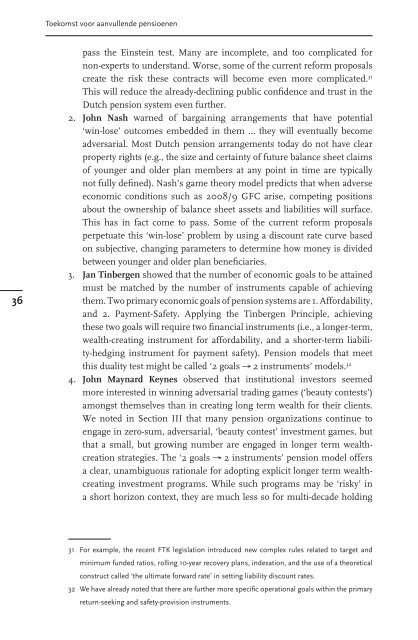Toekomst voor aanvullende pensioenen
Toekomst voor aanvullende pensioenen
Toekomst voor aanvullende pensioenen
- No tags were found...
Create successful ePaper yourself
Turn your PDF publications into a flip-book with our unique Google optimized e-Paper software.
<strong>Toekomst</strong> <strong>voor</strong> <strong>aanvullende</strong> <strong>pensioenen</strong>36pass the Einstein test. Many are incomplete, and too complicated fornon-experts to understand. Worse, some of the current reform proposalscreate the risk these contracts will become even more complicated. 31This will reduce the already-declining public confidence and trust in theDutch pension system even further.2. John Nash warned of bargaining arrangements that have potential‘win-lose’ outcomes embedded in them ... they will eventually becomeadversarial. Most Dutch pension arrangements today do not have clearproperty rights (e.g., the size and certainty of future balance sheet claimsof younger and older plan members at any point in time are typicallynot fully defined). Nash’s game theory model predicts that when adverseeconomic conditions such as 2008/9 GFC arise, competing positionsabout the ownership of balance sheet assets and liabilities will surface.This has in fact come to pass. Some of the current reform proposalsperpetuate this ‘win-lose’ problem by using a discount rate curve basedon subjective, changing parameters to determine how money is dividedbetween younger and older plan beneficiaries.3. Jan Tinbergen showed that the number of economic goals to be attainedmust be matched by the number of instruments capable of achievingthem. Two primary economic goals of pension systems are 1. Affordability,and 2. Payment-Safety. Applying the Tinbergen Principle, achievingthese two goals will require two financial instruments (i.e., a longer-term,wealth-creating instrument for affordability, and a shorter-term liability-hedginginstrument for payment safety). Pension models that meetthis duality test might be called ‘2 goals 2 instruments’ models. 324. John Maynard Keynes observed that institutional investors seemedmore interested in winning adversarial trading games (‘beauty contests’)amongst themselves than in creating long term wealth for their clients.We noted in Section III that many pension organizations continue toengage in zero-sum, adversarial, ‘beauty contest’ investment games, butthat a small, but growing number are engaged in longer term wealthcreationstrategies. The ‘2 goals 2 instruments’ pension model offersa clear, unambiguous rationale for adopting explicit longer term wealthcreatinginvestment programs. While such programs may be ‘risky’ ina short horizon context, they are much less so for multi-decade holding31 For example, the recent FTK legislation introduced new complex rules related to target andminimum funded ratios, rolling 10-year recovery plans, indexation, and the use of a theoreticalconstruct called ‘the ultimate forward rate’ in setting liability discount rates.32 We have already noted that there are further more specific operational goals within the primaryreturn-seeking and safety-provision instruments.




![Proefschrift Hanneke A. Luth[lr]](https://img.yumpu.com/51055008/1/178x260/proefschrift-hanneke-a-luthlr.jpg?quality=85)

![Proefschrift Hanneke A. Luth[lr]](https://img.yumpu.com/24018368/1/178x260/proefschrift-hanneke-a-luthlr.jpg?quality=85)